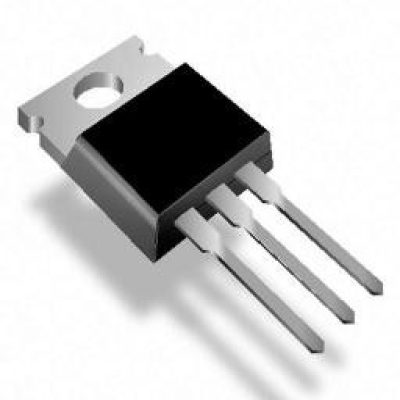BC557 Transistor (PNP, 45V, 100mA)
Description
The BC557 is a PNP bipolar junction transistor (BJT) commonly used for switching and amplification in various electronic circuits. As a PNP transistor.
BC557 Overview:
- Type: PNP (Positive-Negative-Positive) bipolar junction transistor (BJT).
- Package Type: Typically comes in a TO-92 package (three-terminal package: Emitter, Base, and Collector).
- Maximum Collector-Emitter Voltage (Vce): 45V – This is the maximum voltage difference allowed between the collector and emitter terminals.
- Maximum Collector Current (Ic): 100mA – The maximum current the transistor can carry from the collector to the emitter.
- Power Dissipation (Ptot): Maximum 500mW – This is the maximum power that the transistor can dissipate before it becomes damaged.
- Current Gain (hFE): Typically between 110 and 800, depending on the specific model and operating conditions.
- Transition Frequency (ft): Typically 100 MHz, which represents the frequency at which the current gain falls to 1.
Pin Configuration (TO-92 Package):
- Pin 1 – Emitter (E): Current flows out of this terminal in a PNP transistor.
- Pin 2 – Base (B): The base controls the flow of current between the collector and emitter.
- Pin 3 – Collector (C): Current flows into this terminal.
Key Characteristics of BC557:
- PNP Type: Unlike NPN transistors (such as BC327), the BC557 is a PNP transistor, meaning it requires the base to be more negative relative to the emitter for it to conduct.
- Voltage Rating: The BC557 has a lower maximum collector-emitter voltage (Vce) of 45V compared to other high-voltage PNP transistors, making it suitable for low-voltage circuits.
- Current Handling: The BC557 can handle 100mA of collector current, making it useful for low-power switching and amplification tasks.
Applications of BC557:
- Switching Applications:
- The BC557 is often used for switching low-power loads, such as controlling an LED, relays, or other small loads.
- It can be used to switch the negative side of the circuit (since it’s a PNP transistor), which is common in certain control circuits.
- Amplification:
- It is also used in amplification circuits, especially in analog signal processing where low- to medium-power amplification is required.
- Common applications include audio amplifiers, radio frequency (RF) amplifiers, and signal modulation circuits.
- Power Control Circuits:
- It can be used in low-voltage power regulation circuits or as part of a push-pull amplifier configuration for more efficient power control.
- Switching in Logic Circuits:
- BC557 can be used for inverting logic or control lines where the switching action needs to be done by pulling a line to a negative state.
- Relay Drivers:
- BC557 can be used in a circuit to drive a relay. In this case, it would switch on the relay when a small current is applied to the base.
How to Use BC557 in a Simple Switch Circuit:
Let’s look at a basic example of using the BC557 as a switch to control an LED:
Components:
- BC557 PNP Transistor
- 10kΩ Resistor (for base current limiting)
- LED
- 220Ω Resistor (for current limiting to the LED)
- 5V DC Power Supply
Circuit Description:
- Emitter (Pin 1) of the BC557 connects to 5V (positive supply voltage).
- Collector (Pin 3) connects to the negative (cathode) side of the LED.
- The positive (anode) side of the LED connects to the ground (through a 220Ω resistor to limit the current through the LED).
- A 10kΩ resistor is used to limit the current to the base (Pin 2) of the BC557. The other side of the base resistor is connected to a control pin (e.g., an Arduino output pin).
How It Works:
- When the control pin is LOW (0V), the base-emitter junction of the PNP transistor is forward-biased, allowing current to flow from the emitter (connected to +5V) through the collector to the LED. The LED turns on.
- When the control pin is HIGH (5V), the base-emitter junction is not forward-biased, and no current flows through the transistor, turning the LED off.
Important Notes:
- Base Resistor: Like with any transistor, the base resistor limits the current flowing into the base of the transistor. Without it, you may damage the transistor or your control circuit (e.g., Arduino).
- Saturation Mode: To ensure the transistor operates fully as a switch (not as an amplifier), make sure the transistor is in saturation mode, where the base current is enough to fully turn the transistor on.
- Reverse Polarity: In a PNP transistor like the BC557, make sure that the base is more negative than the emitter for the transistor to conduct. If the base is more positive than the emitter, the transistor will be off.
BC557 vs. Other PNP Transistors:
- BC557 is a low-power transistor, handling 100mA of collector current, and has a maximum voltage rating of 45V. For higher current or voltage handling, other PNP transistors like the BD140 or TIP42 might be more suitable.
- BC558 is a similar PNP transistor with similar characteristics and a higher maximum collector current of 800mA. It could be used in similar applications but is suitable for higher-power applications.
Conclusion:
The BC557 is a popular and versatile PNP transistor used for low-power switching and amplification applications. Its ease of use, low cost, and availability make it an excellent choice for various hobbyist and professional circuits. Whether you’re controlling small loads or building amplification circuits, the BC557 can serve as an essential component in your electronics toolkit.
Let me know if you need help with a more specific circuit design or if you have any questions about using the BC557 in your projects!
Only logged in customers who have purchased this product may leave a review.
- Image
- SKU
- Rating
- Price
- Stock
- Availability
- Add to cart
- Description
- Content
- Weight
- Dimensions
- Additional information






Reviews
There are no reviews yet.